A slider, or casement, air conditioner is what you would look for if you need to fit an AC into a sliding window. Not every air conditioner is going to fit into a sliding window.
The ones that fit in such windows have a vertical orientation and are longer than a traditional window air-conditioners.
Casement ACs start from 20 inches in height and above. They come with precut inserts and fasteners that can hold the AC unit in the window frame. While serving to help your unit stay in place, they also eliminate the hassle of buying and installing Styrofoam or plexiglass to block any open space.
At a Glance: Our Top Picks for Sliding Window ACs
- OUR TOP PICK: Frigidaire FFRS0822S1
- RUNNER-UP: PerfectAire 3PASC10000
- LG Energy Star Window Air Conditioner
Comparison of the Best Sliding Window AC
| IMAGE | PRODUCT | |
|---|---|---|
OUR TOP PICK  |
| VIEW LATEST PRICE → |
 |
| VIEW LATEST PRICE → |
 |
| VIEW LATEST PRICE → |
 |
| VIEW LATEST PRICE → |
 |
| VIEW LATEST PRICE → |
 |
| VIEW LATEST PRICE → |
 |
| VIEW LATEST PRICE → |
BEST BUDGET OPTION  |
| VIEW LATEST PRICE → |
Factors to Consider Before Buying a Sliding Window AC
Before you head online to purchase a new sliding window air conditioner, hit the breaks and take a moment to assess a few factors. You don’t want to buy one and find that it won’t work for your home. Please look at these features first before spending any money.
Cooling Performance
When you look at the specifications of an air conditioner, you may notice a BTU measurement. This number gives you an indication of how much cooling capacity it has, revealing how quickly it can lower the temperature in a given space. The larger your living space, the higher the BTU must be.
Floor Area Covered
The main reason the BTU is essential is that it gives a rough idea of the area the AC can cool. For instance, an 8,000 BTU can cover up to 250 sq. ft. in an open space. On the other hand, a 6,000 BTU performs for areas up to 200 sq. ft.
While this is a good benchmark to use, they aren’t always accurate. Ensure that you read the specifications for the floor area the air conditioner can manage. Some can do more than the international standard, while others struggle to perform.
Energy Consumption
All air conditioners use electricity to operate, whether it’s from the wall socket, battery-powered, or solar energy. Most devices have an Energy Efficiency Ratio that reveals how well it uses that power to deliver cooling.
If you’re keen on saving on your monthly electrical costs, ensure that you check out the wattage used. You can then calculate how much you’ll spend per year based on how long you plan on running the AC daily and weekly.
Minimum Dimensions
Since you’re specifically looking for a sliding window AC, the dimensions are one of the most significant factors. You only have so much space to play with in the frame, and a bulky unit that’s too wide or high won’t work.
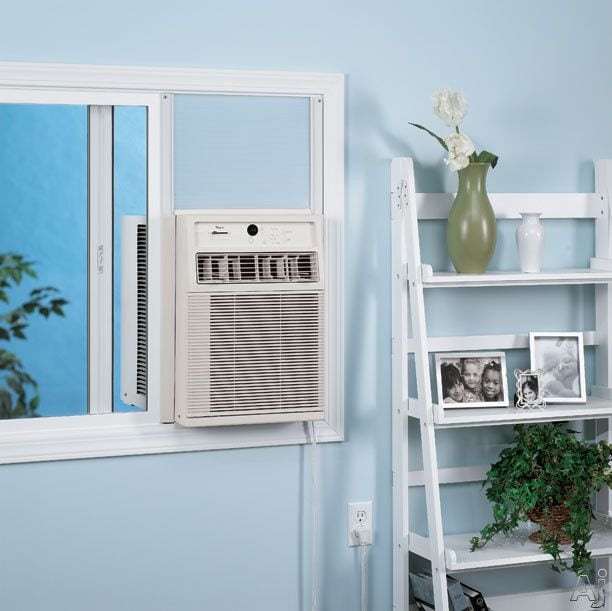
Photo credit: thatsnerdalicious.com
Unless you’re prepared to spend a fortune for no reason, you don’t want to knock out walls just to make more space for an air conditioner. Do your homework and take your measurements before the time.
Noise Levels
Finally, have a look at how many decibels of sound the device produces on a normal day. Now, expand that to include potential rattling against the sliding frame, and you’ll realize how much sleep you might lose. Do yourself a favor and read customer reviews to see whether it’s truly a silent operator.
Advantages and Disadvantages to Vertical Window Air Conditioners
Vertical window air conditioners have a number of awesome qualities, but, as with any air conditioning unit, there are definitely also some drawbacks. Here are the most noticeable pros and cons:
Pros
It can be pretty difficult to beat vertical window air conditioners when it comes to renting a home or apartment without a central AC system. Obviously, installing central AC in such a circumstance is not an option, and window units are one of the most affordable ways to prevent roasting inside your home every summer.
They are also extremely customizable, so it will be simple for you to find a vertical window AC that fits your needs in terms of window size and location, and also provides you some handy features, such as a remote control, Wi-Fi, or temperature sensing ability.
Because these units are installed in windows, you will not have to worry about rigging up some complicated new electrical and hose systems the way you would need to do with a standing indoor AC unit – the water for these systems can just drain right out of the window itself!
Cons
Vertical window air conditioners are not exactly the most attractive element of a home décor system. It is pretty hard to sugarcoat how bulky these units can be. Of course, that is a pretty small price to pay when it comes to being cool and comfortable, and you can always remove the AC unit when it is not the peak of summer.
However, that leads to another potential con – these units can be heavy and complicated to install, so uninstalling and reinstalling may not be the most viable option for a lot of folks. Another thing to consider is that a window AC unit requires actual insertion into your window, which means your window needs to be opened to a certain extent.
This can allow hot, humid outdoor air to pour in and cool air to escape. It also leaves your home more vulnerable. You can mitigate this with insulation and other sealing, but you can’t really get around the fact that on some level, this makes your home less secure.
Horizontal vs Vertical Window AC
You may be wondering why on earth vertical window ACs are even a thing, when most sliding windows tend to slide up and down, not to the left or right.
Wouldn’t a horizontal window unit make more sense in such a sliding window situation? The answer is simple, gravity will exert a different kind of pressure on a window unit that is placed in a horizontally-opening window than one that is placed in a vertically-opening window, for this reason, most newer homes are actually moving away from the horizontal sliding window model and incorporating more vertical sliding window systems.
Think about it: an air conditioning unit that is installed in a vertical sliding window has much more support on either side to hold it in place. An air conditioner installed in a horizontal sliding window does not have that support, and as a result, it tends to tip outward.
In order to prevent this, you would either need a unit that substantially protrudes into the room, which is not exactly ideal, or you would need a block of wood or some other type of support system on the outside of the window, which may not be a viable option if you are installing your unit on the second story.
You can see that a vertical window AC unit makes far more sense. Of course, if you happen to have windows that slide horizontally instead of vertically, you will not have a choice in the matter.
But if you have the option of picking between a vertical sliding window and a horizontal sliding window, you should always go with the vertical one.
The Unique Challenge of Sliding Windows
Unlike a traditional window, a sliding window works from left to right. Side-by-side casement sliders conflict with each other - you usually can’t open both sides at the same time.
The sashes of these windows do not allow a traditional window AC to fit into it. Because of this, a normal AC would leave a lot of space at the top. This brings down the efficiency of the AC or makes you add other fitting work to cover the space. Also, most AC units will be too wide for the typical casement window.
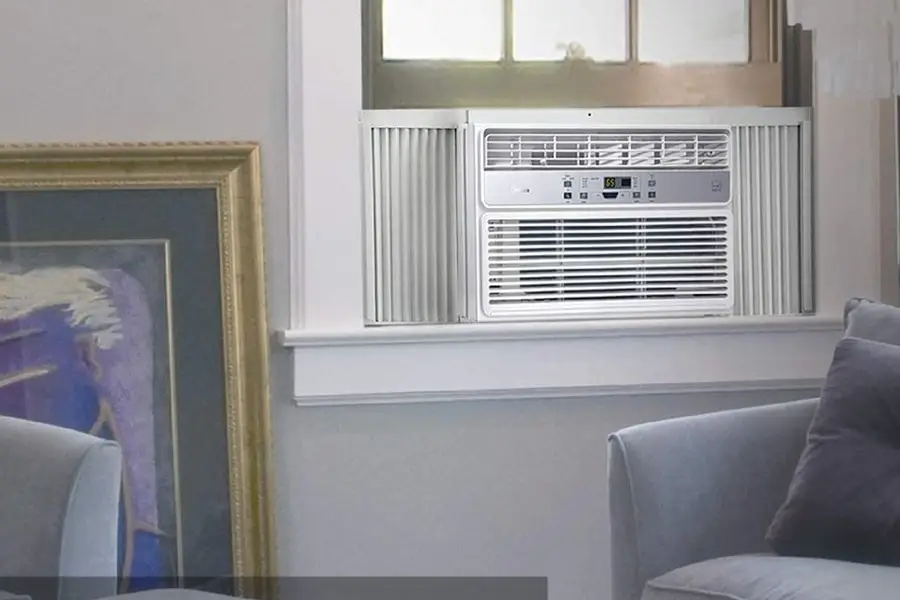
Photo credit: elaborateman.com
Sliding windows come in standard sizes. Measure the size of your window before purchasing an AC unit. The size also influences the power outlet. Larger casement air conditioners require an independent 230-volt circuit and not the normal household 110-volt.
Like any window unit, a casement AC performs best when its rear side is in a shady place. So, the best choice is to use it in a window where there is some shade - a tree, overhang, or even plants or shrubs can help, as long as they aren’t too close.
A metal frame is usually installed first to support the AC unit. This helps protect the window frame and provide extra support to the AC unit itself, preventing it from putting a lot of weight on the sill and window jambs.
Basics of Cooling Potential
Each AC unit has the potential to cool a space based on its BTU rating. BTU indicates the amount of heat that can be removed from a room. A larger BTU rating on an air conditioner means it can cool larger rooms.
Casement air conditioners come with a maximum of 12,000 BTU. That size can comfortably cool a room that is slightly over 500 sq. ft. If you have sliding windows and are looking for an AC for a larger space than that, we recommend that you consider a central air conditioning system.
However, a few other aspects apart from the room size matter when you are measuring BTUs. The height of the ceiling, the use, the floor plan of the house, and the direction of sunlight are some factors that may require you to reconsider the size of the AC unit you buy.
Review of the Best AC Units For Sliding Windows
Here are some brands that have really done their job well and have been positively received. We have reviewed them for you, touching upon different aspects like BTU rating, remote control features, fan speeds, and more.
Best Overall:
Frigidaire FFRS0822S1



PROS
CONS
What Recent Buyers Report
Recent buyers have only positive things to say about this product. They feel that this model brings them all the features without being very expensive. This includes a perfect remote control that gives them more control over the temperature settings. They have also praised the diverse settings that appear on the conditioner that gives them more control over the temperature they want inside of the room.
Why it Stands Out to Us
Among many other things, this air conditioner stands out to us because of its amazing dehumidification tendency. Rooms can get really stuffy, and bad smells can develop after a couple days of traveling. This, coupled with humidity, can give rise to algae and moss and can make the inside of the room unbreathable.
To help reduce the humidity effects, this portable air conditioner has the ability to remove more than 3 pints of water from the air each hour.
Who Will Use This Most
This model comes with a relatively lower BTU, but this is compensated by a good SEER level. This air conditioner isn’t very big, either, which makes it easy to install. Moreover, it also reduces the energy consumption of the model and makes it economical in the long run. The power it requires to run is 115V. Moreover, the model has the ability to cool rooms up to 350 sq. feet.
Bottom Line
With a perfect energy Seer and better humidification factor, this model is already making rounds in the industry and is considered as one of the most reliable ones. This is also assured by the company providing a better overall warranty. This, coupled with the high-end construction of the model, increases the faith of buyers towards the model.
Runner-up:
PerfectAire 3PASC10000

PROS
CONS
What Recent Buyers Report
The majority of buyers were extremely satisfied with their purchase and particularly loved the functional remote that doubled as a thermostat. Although some users found the unit’s operation to be a bit noisy, most stated that it was easy to install and cooled well.
Why it Stands Out to Us
Boasting four different operating modes, this unit enables users to fully customize their climate. It offers dehumidification, auto, a cooling mode, and a fan mode, and gauges the natural climate changes to determine the operating mode that will best suit your needs. It further features a washable and removable air filter that ensures healthy and clean air.
Who Will Use This Most
This 10,000 BTU unit can cover areas of up to 450 square feet. It’s also programmable, so you can set it to switch off and on by itself. This makes it perfect for those who want to conserve energy or want the house cool before they return. However, its operation is a bit noisy so it may not be suitable for the bedroom if you’re a light sleeper.
Bottom Line
Cooling rooms measuring up to 450 square feet, this PerfectAire model easily fits in architectural windows, eliminating the need for costly custom designs. With three fan speeds, full-range direction control, and adjustable temperature settings, it allows you to easily find your comfort zone.
3. LG Energy Star Window Air Conditioner

PROS
CONS
The LG Energy Star Window Air Conditioner is a fantastic sliding air conditioner that will make your life a thousand times easier with its Wi-Fi control option. Once you download the LG SmartThinQ app on your smartphone (compatible with both iPhones and Android models), you will be able to use Wi-Fi to adjust your air conditioner’s fan speed, temperature, and mode, as well as, have the option to schedule an automatic shut down or start-up at a future time.
If you are more old-school and are interested in the unit’s manual features, there are a number of those as well. The indoor vent points upward and circulates the cool air throughout the room, instead of just blowing it straight out, the way a front facing vent would do, and the outdoor vent can be closed in order to block any stinky outdoor smells if you happen to live on a city street. Best of all, the Energy Star economy mode will still work on extremely hot days when electric companies will lower the amount of available power.Bottom Line
The LG Energy Star Window Air Conditioner is a great unit with some incredibly convenient aspects. It may take a little longer to set up, however, because the instructions are not very specific.
4. Frigidaire FFRS1022R1



PROS
CONS
Frigidaire offers a range of casement units. This one is a 10,000 BTU. That can cool a room about 450 sq. ft.
This unit can pull up to 3.4 pints of water out of the air per hour. It plugs into a standard 115 V electrical outlet.
Other features include multi-speed electronic controls with 24-hr on/off timer and a full-function remote control. It has auto cool, energy saver, and sleep modes. It also offers 4-way air direction and a washable mesh filter with a “check filter” alert.
It fits sliding windows with a minimum height of 21.5 inches up to 40 inches. The window must be at least 15.5 inches wide.
Bottom Line
Frigidaire provides a limited 2-year warranty and a 3-5 year warranty on a sealed system.
5. Koldfront CAC8000W



PROS
CONS
What Recent Buyers Report
Most recent buyers are thrilled to have finally gotten their hands on a superior model that is cost-efficient in the short and long run both. It is extremely compact, making it easily portable. This also makes its installation in a range of windows easy. Not only this, but buyers are also pleased with the high SEER of the model, which makes the model have a good overall impact.
Why it Stands Out to Us
The model’s control panel is its novelty and offers users the most comfort. It comes with a very easy to see and operate digital display. Unlike other models, this isn’t very small and is visible from afar too.
Moreover, it comes with different fan speeds that control the airflow inside the room. People residing inside the room or RVs can easily change the fan speeds according to their mood. The dehumidification ability is also noteworthy.
Who Will Use This Most
The model is made for people who want cost efficiency, as well as speed efficiency at the same time. It comes with 3 different fan speeds, and its remote control has a range of 16ft. This means that larger RVs can also make use of these air conditioners.
Moreover, the model is not very tall, which makes installation easy. It can cool a room that is about 350 sq. ft., making it suitable for a range of RVs and other rooms.
Bottom Line
With this portable air conditioner, keep the summer heat aside and enjoy non-stop and never-ending cool breezes at all times, even inside your RV. This compact air conditioner is one of the easiest ones to install and does not require any additional hardware for its installation. It also comes with good BTU. But the reason most people prefer it is because of its relatively lower price.
6. Koldfront CAC10000W



PROS
CONS
What Recent Buyers Report
Users looking for more efficiency absolutely love getting their hands on this portable air conditioner. This not only provides them with better regulation, but its amazing dehumidification technology ensures that the inside of your room is always ventilated and free from any foul smell. Not only this, but it also decreases the growth of tiny microorganisms inside.
Why it Stands Out to Us
The Koldfront BTU is the most noteworthy feature of the model, and everyone will agree that having higher BTU makes your air conditioner more powerful. It can gradually decrease the temperature inside of your room by removing more amount of heat per minute. Not only this, but it also decreases energy wastage and provides you with a good overall yield.
Who Will Use This Most
The model comes with all installation software that you will need for its proper placement. It also comes with all the weather seals, which means that you don’t have to hire a professional to install it. It also has a relatively higher BTU and energy SEER, which makes it suitable for larger rooms. So if you live inside a tiny cabin or a small RV, then it is recommended that you invest your money in a smaller air conditioner.
Bottom Line
When compared to its counterparts, this model has a relatively higher BTU, which makes it the most energy-efficient model in this review. It also has the ability to cool extremely large rooms, ranging from 400 to 450 sq. ft. Although this makes the model slightly expensive, the plethora of features that it promises the users makes it worth a few extra bucks.
Best Casement Window Seal
HOOMEE 400



PROS
CONS
What Recent Buyers Report
There are many reasons why this seal is considered one of the best, the top being its ability to help regulate fuel consumption. There are 2 reasons why this is appreciated by recent buyers. They praise it for being a cost-effective model that lowers the electricity bills in the long run.
Moreover, with global warming on the rise, it helps recent buyers protect the planet by lowering their carbon footprint.
Why it Stands Out to Us
The main purpose of a portable air conditioner is to increase the cooling in your room, and ensures a properly balanced distribution of cold air in all corners of your room by not allowing air to escape through gaps in the window.
It also zips around the nozzle of the hose and blocks any kind of warm air from returning. This, coupled with better efficiency, helps ensure that people sitting in all corners feel an equal amount of cold.
Who Will Use This Most
Unlike other models, this one doesn’t come with a restriction of size. It can fit around any casement air conditioner. It is also suitable for most of the windows in your home that open from left to right. It can fit in windows with a maximum distance of 400 cm between the panels.
Bottom Line
With so many amazing features at its disposal, it’s no wonder it had to be included on our list. It comes with high-end construction that offers better durability and strength. It also offers easier installation and does not require a professional to do it. If you are looking to increase the efficiency of your air conditioner, this window seal will fit the bill perfectly.
Best Casement Window Air Conditioner:
hOmeLabs 5000 BTU Window Mounted Air Conditioner



PROS
CONS
The interface does not light up, meaning you will not have to worry about obnoxious glowing lights at night. This unit comes with four different settings, two fan settings and two cooling settings. It will cool a room even when on the lowest setting – we guarantee you will be impressed.
And you will be even more impressed when it comes to the (non)impact this unit will have on your electrical bill. Users report that even when they are running the unit continuously, their bill only increased by about $20. A small price to pay for comfort in the heat of the summer!
Finally, this unit is also incredibly easy to use. Installation, filter changing, and everything else about this air conditioner are simple and easy to figure out.
Bottom Line
The hOmeLabs 5000 BTU Window-Mounted Air Conditioner is a great product for cooling one room within your larger apartment or home. Due to its size, it will likely not be able to cool much beyond that.
9. Keystone 5,000 BTU 115V Window-Mounted Air Conditioner



PROS
CONS
Hands down, the coolest thing about this unit is the remote control, which comes with a temperature sensing “follow me” option. This feature essentially allows the unit to read the temperature wherever the remote is and adjust the temperature accordingly, as opposed to most units, that can only read the temperature where the unit is actually placed. With this option, you can carry the remote around with you and the unit will adjust the temperature for wherever you actually are!
It also comes with a number of other convenient features, including the ability to shut off the lighting on the unit’s face so it will not glow obnoxiously at night.
Bottom Line
The Keystone 5,000 BTU 115V Window-Mounted Air Conditioner is an effective air conditioner that will cool where you are, not where it is. It does have a complicated drainage system, though.
10. Global Industrial Casement Window Air Conditioner 10,000 BTU



PROS
CONS
Global Industries produces this decent 10,000 BTU AC unit - that will meet you needs for a room around 450 sq. ft. This AC runs on 115V.
A 4-way air directional fan helps cool the whole room evenly. It comes with a washable filter, so you won’t have to worry about replacements until you’ve really worn that one out.
This device can be operated by remote control. Other features include auto restart, sleep mode, and a 24hr on/off timer.
Bottom Line
Global Industrial offers a 1 year parts & labor warranty and a 5-year sealed system warranty.
Casement vs Sliding Windows: What’s the Difference?
A casement window has a frame that’s taller than it’s wide. It has a catch or a lever to open the window outwards or slide upwards. They are also known as crank windows and are the usual types you’ll find in residential homes.
Sliding windows are wider than they are tall, opening sideways with a slider mechanism to move the glass along the frame. Some of these are harder to open, but you can buy rollers, sashes, and lift rails to move them along easier. The air conditioner for these windows will still be longer in height than width, but it considers the shorter dimensions.
Whichever window type you have, the AC unit will slot into them differently with various fixtures and attachments. Make sure you take the right measurements before you buy one at your local store.
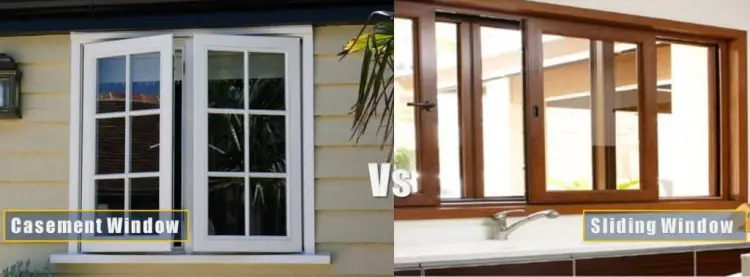
Photo credit: mccoymart.com
Top Brands With AC for Sliding Windows
You’ll find plenty of brands to choose from when you shop online or in your local store. Some of them have an impressive reputation, which comes with a high price tag. Others are lesser-known names but still deliver amazing performances. Let’s take a look at three companies that excel in the sliding window sector.
Keystone
You’ll find several air conditioner types and capacities in Keystone’s catalog. With a passion for research and development, it’s always finding ways that it can improve AC technology to make residential and commercial life more comfortable. You’ll find a few sliding window devices in its portfolio that also delivers dehumidification functions.
Whynter
With humble beginnings in 2006, Whynter is a company that thrives on smart technology and innovation. While it also sells home appliances, its primary focus is on HVAC systems with several intelligent features. The company loves creating elements that function differently from the norm, making it stand out from the rest.
Honeywell
You may have seen this name all over Amazon and other online distribution centers. Its fame goes back to 1885 when the first regulator for coal furnaces was invented.
Since then, it’s been spreading its wings into cooling, heating, dehumidification, purification, and humidification. You’ll certainly find casement and sliding window air conditioners among its products.

Adding Security
You’ll be happy that you’ve found an efficient cooling option to cool your room with a sliding window. However, you might still be concerned about security, since it is easy to pry open the window or break it.
To help prevent anyone from sliding the window open further and popping out the AC unit, you can cut a piece of wooden dowel (like a broom handle) to block your window. Just wedge it on the opposite side between the window jamb and the frame.
Some windows also offer locks for different positions. Or you could look for special casement window lock units at your local hardware store. Securing the top mounting rail into the window sash with its screws is another security measure and provides your unit with more stability.
The accordion panel on the AC might also be a weakness. Be sure it’s fastened in place. A more extreme measure would be to have a grill made to go over the section. The next step would be to install a stick-on type window alarm. While being a good way to know when you’re facing a burglar, their visibility can also be a great deterrent.
We have a full article covering everything you need to know about window air conditioner security that you can check out if you need more info.
Life Hacks
Purchasing a casement air conditioner could be an expensive proposition, especially if you moved into a new house or apartment thinking your old window AC unit would work.
There are many hacks you can use to make a traditional unit work. There are many online resources that provide detailed instruction manuals and guides that will help you fit a traditional, horizontal AC in a sliding window. But it’s often necessary to get a carpenter to create the right sized frame for your window.
Of course, you may need an electrician as well, but that could be the case anyway, depending on where your outlets are located and whether your unit is 120 or 220 volt.
We don’t find this a preferred method. It’s possible and if done by a competent installer, it is safe. But it can void your warranty because the unit is supposed to have a definite “top”. And if not done correctly, it can be hazardous because of electrical problems, poor ventilation, or poor drainage. If you’re willing to take the risks, you can find various guides through Google, however please use caution.
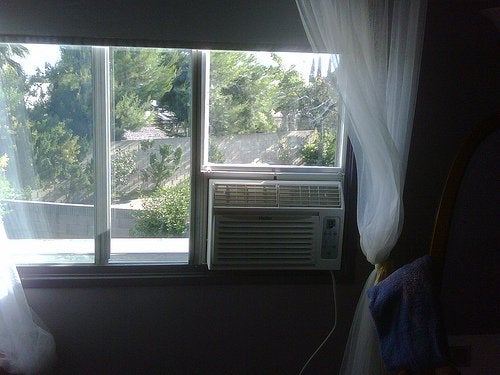
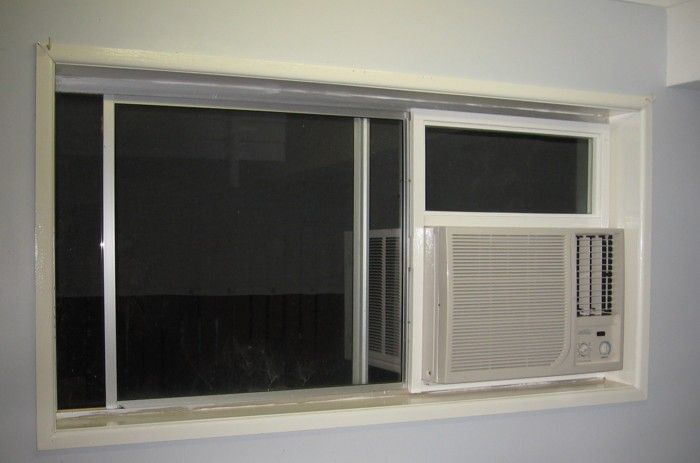

Photo credit: reddit.com
How to Install Portable Air Conditioner in a Horizontal Sliding Window
You may have gotten the best portable air conditioner on the market, but unless you learn to install it inside your sliding window, you won’t be able to enjoy its benefits. To help you make things easier, here is our step by step guide for AC installation. Make sure you watch the video link given below to have a better understanding of these steps.
- The first step is to measure your AC from the left side to the right side, including the frame of the AC.
- Then cut the pieces of your C channel in half. In the first section, insert the nut rod by coupling it on one end.
- You need to then drill a hole on the side of the frame. This will be done through the channel and by coupling it with a screw.
- You need to make sure it’s flushed on each end.
- Then you need to measure your windows from top to bottom. You need to make sure this includes the inside of the frame too.
- This is important because you need to fit the AC channel into the frame.
- You need to then place your AC inside of your frame and slide it carefully to the side frame as far as you can. If the frame inside of your AC is well attached, you should not worry about any issue, such as, the unit falling out.
- You need to then insert the vertical C channel and drill a hole right above the horizontal channel. Then you need to screw the two together to ensure they are properly attached.
- You need to then screw your C channel into place by using self-drilling screws. You will also have to drill through the window frame in order to do this.
If these steps are too difficult to understand, you can have a look at the following video to get a better understanding.
Conclusion
Casement air conditioners are designed for the very specific needs of sliding windows. These units are designed to address special challenges of the window size and shape, so we definitely recommend using this type of unit where needed. It will serve you well and faithfully!
Ease of installation can vary, but many models are DIY. But you can always consult a carpenter or electrician for help where needed. There’s no reason to suffer in the heat just because of your window type - casement AC units are both good to look at and highly functional!
People Also Ask
Coming across multiple reviews on the internet, we noticed how people are still confused about the sizes of the models. They also ask numerous questions regarding the installation and the size that fits the window. So to help all these people out, we decided to answer some of the most popular questions by you.
What is a Casement Air Conditioner?
A casement air conditioner works with windows that are longer in height than width. Therefore, they are extremely narrow devices that cater to the specific window frame you want to install it into. A minimum recommended width is generally 15.5”.
How Do Casement Window Air Conditioners Work?
These air conditioners work the same as normal ACs when it comes to cooling performance and electrical consumption. It draws the warm air from your house, uses a condenser to cool it, and returns colder air into your home. The warm air exhausts out the back to the outside.

Photo credit: youtube.com
Can You Put a Regular Air Conditioner In a Casement Window?
It’s possible to install a regular AC in your casement window if you have the right dimension, a window installation kit, and some bracers. It’ll require more work than is necessary, which is why it would be better to look for a casement air conditioner instead.
Can a Vertical AC Be Installed In a Wall?
Vertical air conditioners generally vent hot air out the sides, while actual wall ACs do so at the back. If you install a vertical AC through your wall, it may block the exhaust vents and create massive problems for your home and device. It’s best to check if the vertical AC is compatible with a wall installation.
Can You Put an Air Conditioner in a Sliding Window?
Most of the window air conditioners are meant to fit inside a vertically sliding window only. This means that larger and horizontal sliding windows in your house will be left out. So, before you invest in a room conditioner, make sure you check the BTU setting and buy only the most appropriate size.
Can You Put an AC Sideways in a Window?
This is one of the most popular questions asked. If you have a window that can slide open from left to right side and a regular-sized window air conditioner, then it is best you don’t install the appliance in the window by turning it towards one particular side. Doing this might result in the burning of your compressor and hence disrupting the unit that’s inside.

